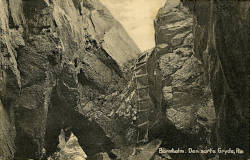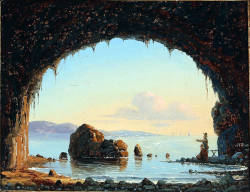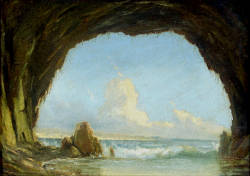Sorte Gryde
Useful Information

| Location: |
Helligdomsvej 14, 3760 Gudhjem.
Alternatively park at Bornholms Kunstmuseum, Otto Bruuns Plads 1, 3760 Gudhjem. 330 m, 5 minutes walk. (55.224547, 14.899180) |
| Open: |
no restrictions. [2023] |
| Fee: |
free. [2023] |
| Classification: |
 Sea Cave Sea Cave
|
| Light: | bring torch |
| Dimension: | L=60 m. |
| Guided tours: | self guided |
| Photography: | allowed |
| Accessibility: | no |
| Bibliography: | |
| Address: |
Sorte Gryde, Helligdomsvej 14, 3760 Gudhjem.
Bornholms Kunstmuseum, Otto Bruuns Plads 1, 3760 Gudhjem. |
| As far as we know this information was accurate when it was published (see years in brackets), but may have changed since then. Please check rates and details directly with the companies in question if you need more recent info. |
|
History
Description


Sorte Gryde (Black Pot) is located on Bornholm island, which is located rather far to the east of Denmark. It has a different geology than the rest of the country, the crystalline rocks of the island form sea caves. This sea cave is located at the Helligdomsklipperne (Sanctuary Cliffs) on the northeast coastline. Sorte Gryde is a crack in the rock which was widened by the waves and forms now a 60 m long passage, which is narrow and high. It is home to the Bornholm cave spider. Beneath the entrance there is a short connection to the sea, more like a natural bridge than a cave, which is called Hans Grønbechs Ovn.
The Helligdomsklipperne are up to 22 m high cliffs. They were named after a legendary holy spring which is said to have risen at the foot of the cliffs in earlier times. The also gone Medieval Trefoldighedskapellet (Trinity Chapel) above the cliff used the life spending water which was collected from the spring to heal pilgrims. The main festivals were Sankt Hans Aften and Midsummer. It seems the amount of water was already insufficient in this time, as a woman was paid to fill it up with water from the sea. The different cliffs actually have names like Lyseklippen (Light Rock), Mågetårnet (Seagull Tower), Måneskinsklipperne (Moonshine Cliffs), or Kærlighedsbænken (Love Bench).
About 100 m east of Sorte Gryde is a second cave located, Tørre Ovn (Dry Oven). The caves on Bornholm island are often called Oven, which is local custom, not the Danish word for cave. This is the dry oven because it’s above the sea level and best visited on foot.
Between the two is the Våde Ovn (Wet Oven), which is quite small and at sea level, hence the name. Unfortunately most sea caves are at sea level, so there are several Våde Ovn on Bornholm. The one on the western coast is actually much bigger and more interesting. All the caves are accessible from the trails on the cliff, there are stainless steel staircases and ladders to climb down to the cave entrances.
The rocks here are 1.7 Ga old striped gneiss crisscrossed by an abundance of little diabase channels. Cracks were filled in with additional quantities of magma and diabase. The caves are a result of the erosional removal of the softer material in the channels.
During summer, the small boat M/S Thor departs several times a day from Gudhjem to the Helligdomsklipperne. The view from the sea is more spectacular than from the top of the cliffs, but it is not possible to visit the caves.
The view of the rocks was painted over time by numerous Bornholm painters, like Otto Haslund, Karl Isakson, Oluf Høst, Vilhelm Kyhn, and Michael Ancher. There are several historic paintings of the Våde Ovn, which are quite impressive. Seeing the caves today gives the impression that the artists exaggerated considerably when painting them.
- See also
 Search DuckDuckGo for "Grotte Sorte Gryde"
Search DuckDuckGo for "Grotte Sorte Gryde" Google Earth Placemark: Sorte Gryde
Google Earth Placemark: Sorte Gryde Google Earth Placemark: Tørre Ovn
Google Earth Placemark: Tørre Ovn Google Earth Placemark: Våde Ovn
Google Earth Placemark: Våde Ovn OpenStreetMap
OpenStreetMap Helligdomsklipperne - Wikipedia (visited: 18-APR-2023)
Helligdomsklipperne - Wikipedia (visited: 18-APR-2023) Sanctuary Cliffs - Helligdomsklipperne (visited: 18-APR-2023)
Sanctuary Cliffs - Helligdomsklipperne (visited: 18-APR-2023) Helligdomsklipperne, Rø
Helligdomsklipperne, Rø  (visited: 18-APR-2023)
(visited: 18-APR-2023)
 Index
Index Topics
Topics Hierarchical
Hierarchical Countries
Countries Maps
Maps